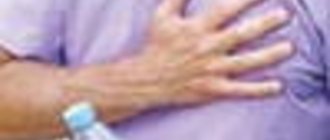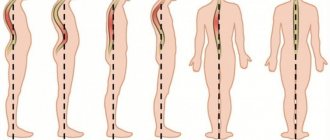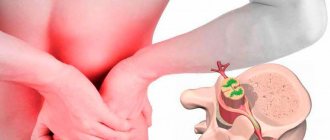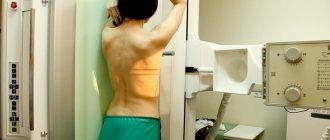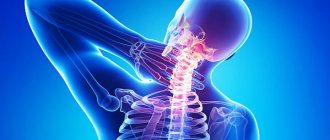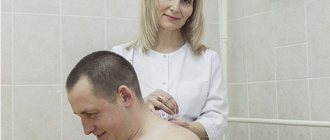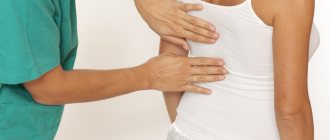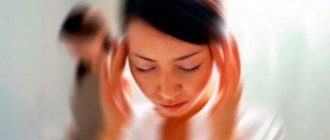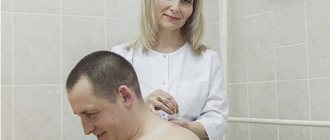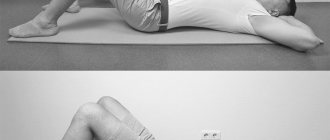Osteochondrosis usually refers to a whole complex of symptoms that include degenerative changes in the vertebral discs, leading to disability. Changes can occur due to natural wear and tear of the spine or as a result of disorders in the body that lead to weakening of the discs. Complicated conditions of osteochondrosis can cause severe pain in the patient due to damage to nerve roots or muscle swelling. There are also other symptoms such as numbness, limited mobility, spasm. In such situations, manual procedures alone cannot be used; drug treatment is necessary. The most common type of osteochondrosis is the lumbar spine. This area suffers the most under stress, so changes in it appear faster and more often.
What is osteochondrosis
Lumbar osteochondrosis is a degenerative pathology of the vertebrae in the lumbar region. The disease affects not only the spine, but also the neurovascular system. Symptoms are divided into vertebral and non-vertebral syndromes. In the first case, the symptoms appear only on the vertebrae, but in the second they affect the nerves and blood vessels.
Treatment of lumbosacral osteochondrosis
Drug treatment of the disease, as a rule, includes the prescription of a number of medications that differ in the nature of their effect on the body. Most of them are used to eliminate the unpleasant symptoms of osteochondrosis and improve the quality of life, as well as performance. Moreover, each drug is selected strictly individually, depending not only on what manifestations of the disease bother the patient, but also on the nature of the existing concomitant diseases.
Thus, for lumbosacral osteochondrosis the following may be indicated:
- NSAIDs;
- corticosteroids;
- muscle relaxants;
- chondroprotectors;
- vitamins;
- products for topical use;
- drugs that improve microcirculation.
NSAIDs
Drugs of the NSAID group or non-steroidal anti-inflammatory drugs are a broad pharmacological group, the representatives of which have varying degrees of analgesic and anti-inflammatory properties. They are produced in almost all known dosage forms, including tablets, capsules, topical products, and injection solutions.
The choice of release form, as well as a specific drug, is made exclusively by a doctor after a comprehensive examination of the patient. In mild cases, the use of local remedies is indicated, for more noticeable pain, drugs intended for oral administration, and for severe pain, intramuscular injections.
NSAIDs should be used only on demand, i.e. when pain occurs.
A negative property of drugs in this group is a negative effect on the mucous membranes of the intestines and stomach, which manifests itself with long-term use. Therefore, in such situations, exacerbations of peptic ulcers and gastritis may occur, including bleeding. Due to these characteristics of the action of drugs from the NSAID group, proton pump inhibitors are prescribed in combination with them, especially if long-term use is necessary.
Safer NSAIDs have already been developed and released, which have a selective effect on the body and have virtually no effect on the gastrointestinal tract. But their cost remains quite high, which makes them inaccessible to many patients with lumbosacral osteochondrosis.
Corticosteroids
Corticosteroids are hormonal drugs indicated for severe inflammatory processes. Due to the possibility of causing a number of undesirable consequences, they are usually prescribed in the form of injections and only in the most difficult cases, when the pain becomes unbearable.
Corticosteroids are often used to perform paravertebral blockades of the lumbosacral spine. The procedure involves injecting a mixture of corticosteroid and local anesthetic directly near the spine. This allows you to quickly relieve even very severe pain. But blockades can only be carried out in a medical institution by specially trained medical personnel, since if the technique is not followed, the passing nerve can be injured, which will cause the development of complications. In this case, blockades are recommended to be performed no more than 4 times during the year.
Muscle relaxants
Muscle relaxants are a group of medications that help relax overly tense muscles. Since tight, spasmodic back muscles contribute to increased pain, after the administration of drugs, patients usually notice an improvement in their well-being.
Chondroprotectors
Chondroprotectors are a relatively new group of drugs, the active ingredients of which are mainly glucosamine and chondroitin. These compounds are absolutely natural for the human body and are used by it for the natural restoration of cartilage tissue after stress. Therefore, today chondroprotectors are included in the list of drugs most often prescribed for lumbosacral osteochondrosis.
But in reality, there is still no unambiguous evidence in favor of the high effectiveness of these drugs. It has been noted that their use is most effective at the earliest stages of osteochondrosis development. In such cases, you can really count on activating the natural processes of regeneration of intervertebral discs and improving the patient’s condition. But in more complex situations, they can only slow down the further development of degenerative changes in the discs and help avoid the formation of protrusions and hernias.
Chondroprotectors are available in the form of capsules, powders for internal use, products for topical use, as well as solutions for injections. The latter are the most effective, but the course of treatment with chondroprotectors is designed for at least 30 days, which, combined with the inconvenient form of use and high cost of the drugs, often forces patients to refuse to use them.
Vitamins
As an addition to the prescribed treatment, a course of vitamins is often recommended, since with lumbosacral osteochondrosis there is a high risk of compression of the spinal roots. Vitamins, in particular B vitamins, help improve nerve conduction, which reduces the risk of disorders of the pelvic organs and lower extremities.
Topical products
In addition to the local drugs from the group of NSAIDs and chondroprotectors discussed above, locally irritating and warming drugs can be prescribed for lumbosacral osteochondrosis. Such ointments, gels or creams will provoke irritation of skin receptors in the area of application, which will not only promote more active blood flow to the affected intervertebral discs, but also reduce pain.
Medicines
These medications are prescribed to activate blood circulation in the lumbosacral region. As a result, the speed and intensity of metabolic processes will increase. This in turn will create favorable conditions for the intervertebral discs and will help stop their further destruction.
Exercise therapy
Physical therapy or exercise therapy is one of the main methods of treating lumbosacral osteochondrosis. But it is important to understand that there is no universal training program. In order for exercise therapy to bring tangible benefits and not cause harm, it is important that all exercises and the amount of load are selected individually in accordance with the severity of degenerative changes in the intervertebral discs, the nature of existing concomitant diseases or complications of osteochondrosis, age, and level of physical development of the patient.
Therefore, it is initially recommended to attend special groups or work individually with a physical therapy instructor. A specialist, in accordance with the recommendations of the attending physician, will select the optimal exercises and help you master the correct technique for performing them as accurately as possible. Gradually he will increase the load, which will contribute to obtaining the best result. Patients can then practice on their own at home.
Thanks to exercise therapy it is possible to:
- relieve pain in the lumbar region;
- eliminate muscle tension and spasms;
- activate blood circulation in the affected area;
- strengthen the ligamentous apparatus and muscle corset, which will create strong support for the spine;
- increase the mobility of the spine.
It is important not to neglect physical therapy, since the effectiveness of the entire treatment largely depends on it. The set of exercises recommended by a specialist should be performed daily in comfortable conditions. It is important to avoid making sudden movements or rushing. If pain occurs during exercise, you should immediately stop performing the exercise that caused it and consult your doctor.
All patients with lumbosacral osteochondrosis are recommended to take up swimming, since physical activity in water does not load the spine and intervertebral discs, but helps strengthen muscles. Therefore, it is recommended to visit the pool 2-3 times a week. Patients can also do yoga or Pilates, which have a very positive effect on the condition of muscles and joints.
Manual therapy
Manual therapy is rightfully considered one of the most effective methods of treating lumbosacral osteochondrosis, as it can have a positive effect directly on the spine and significantly improve the condition of the intervertebral discs, as well as the functioning of the body as a whole, which leads to a rapid and tangible improvement in the patient’s condition. Thanks to the competent conduct of manual therapy sessions for the treatment of lumbosacral osteochondrosis in Moscow at the Institute of Human Restoration clinic, it is possible to achieve:
- restoring the normal position of the vertebrae, increasing the spaces between their bodies and reducing pressure on the affected intervertebral discs;
- releasing pinched nerves and eliminating neurological symptoms;
- reducing the severity of pain until complete elimination;
- normalizing the tone of the back muscles, in particular relaxing spasmed muscles and bringing too relaxed ones back to normal;
- eliminating functional blocks and increasing mobility;
- ensuring normal functioning of the pelvic organs.
Do not confuse therapeutic massage and manual therapy sessions, since when performing the first, only the soft tissues of the back are actively worked, while manual therapy involves a targeted effect on the spine.
It is extremely important to be scrupulous in choosing a chiropractor, since working with the spine requires pinpoint precision, and careless or too strong movement can lead to undesirable consequences and the development of complications of osteochondrosis of the lumbosacral spine. The author's method, invented and patented by A.G. Gritsenko, deserves special attention. In addition to the traditional techniques of post-isometric relaxation, mobilization, manipulation, it involves special effects on the spine. Thanks to this, it is possible to achieve the best effect and stop further progression of osteochondrosis, as well as create the most favorable conditions for the natural restoration of intervertebral discs. In addition, when using Gritsenko’s original method of manual therapy, a general strengthening effect on the body is ensured, immunity is increased and, in general, the functioning of all organs and systems is improved.
Physiotherapy
Physiotherapy is indicated outside of exacerbation of osteochondrosis of the lumbosacral spine. Thanks to the use of physiotherapeutic methods, it is possible to consolidate the achieved treatment results and potentiate the influence of other therapeutic measures taken. As a result, the patient’s well-being improves even more and approaches normal as much as possible, which allows him to lead a normal lifestyle and maintain full working capacity.
Physiotherapeutic procedures are prescribed in courses of 10-15 sessions, and which of them will be indicated for the patient is selected by the doctor based on the characteristics of his condition. It could be:
- electrophoresis with the introduction of drugs - the use of a weak electric current ensures deeper penetration of the active substances into the tissue and obtains a more pronounced therapeutic effect;
- magnetic therapy – stimulates blood flow in the area of influence and activates metabolism, and also has an analgesic and anti-edematous effect;
- laser therapy – the thermal effect of a laser provides an anti-inflammatory, vasodilating effect, which helps reduce the severity of pain;
- Ultrasound therapy - allows you to reduce the sensitivity of nerve endings to pain impulses, as well as reduce the severity of inflammation at the site of exposure, which in combination produces an analgesic effect.
Sometimes other methods are prescribed, in particular diadynamic currents, acupuncture, etc. The use of the Kuznetsov iplicator has a very positive effect on the patient’s condition.
Traction therapy
Traction therapy or spinal traction allows you to increase the distance between the vertebral bodies and thereby reduce their pressure on the intervertebral discs, providing better conditions for their recovery. The procedures are performed on a special table, under the supervision of medical personnel.
Symptoms of lumbar osteochondrosis
Vertebral syndrome:
- rachiocampsis;
- lumbar muscle tension;
- decreased mobility of the vertebrae in the lumbar region;
- painful sensations.
Extravertebral symptoms can be reflex and radicular.
Reflex syndrome is accompanied by:
- constant or sharp pain in the lumbar region after physical activity;
- morning stiffness and decreased mobility due to constant muscle tension;
- shooting in the lower back or leg;
- numbness, tingling or burning, as well as decreased sensitivity of the lower extremities;
- disturbances in the functioning of the intestines and bladder, as well as in sexual function;
- irritability, sudden mood swings and fatigue.
Radicular symptoms arise due to the effect of lumbar osteochondrosis on the nervous system. These include:
- muscle weakness;
- decreased sensitivity;
- radicular pain;
- decreased reflexes or their complete loss.
Causes of lumbar osteochondrosis
The main reason for the development of lumbar osteochondrosis is that the load on the spine is distributed unevenly. The disease can begin to develop due to the habit of carrying a bag on one shoulder, sleeping in a sitting position or on too soft a surface, or wearing anatomically incorrectly designed shoes. In addition, factors such as:
- physical activity exceeding the norm for the body;
- neuro-emotional crisis;
- metabolic disorders;
- diseases of the gastrointestinal tract;
- genetic predisposition;
- poor posture during the development of the musculoskeletal system;
- hypovitaminosis caused by poor diet;
- multiple pregnancy;
- smoking.
Additional causes include a sedentary lifestyle, excess weight and back injuries.
Lifestyle correction
The first thing the doctor does after discovering lumbosacral osteochondrosis is to recommend that the patient make a number of specific changes to his lifestyle. They will vary in different cases and depend on individual characteristics. So, if the patient is overweight, he will be advised to take measures to eliminate it. This could be a transition to a more rational, healthy diet, or an increase in the level of physical activity. But any grueling workouts and one-component diets for weight loss are strictly contraindicated!
If lumbosacral osteochondrosis is diagnosed in an office worker, he is advised to increase the level of physical activity. As a rule, it is worth leaving your workplace every hour to stretch and restore normal blood circulation in all parts of the body. It is also recommended to walk outdoors more often. This will not only help you feel better, but will also help improve your sleep quality.
With the development of lumbosacral osteochondrosis in people engaged in heavy physical labor or prone to frequent grueling workouts, they will, on the contrary, be recommended to reduce the load on their back or even change the type of activity. Weightlifting, wrestling, and jumping sports are contraindicated for this disease.
Diagnostics
To make a diagnosis, you should contact a neurologist. Treatment of lumbar osteochondrosis without a neurologist's opinion is not only ineffective, but also dangerous. Depending on the clinical situation, the doctor will refer the patient for MRI, ultrasound, or CT. Our clinic has the required diagnostic facilities for comprehensive detection and treatment of pathology.
Treatment methods
Manual therapy is a complex of highly effective methods that allows you to return muscles to their natural physiology, eliminate spasms and stabilize the nutrition of the vertebrae. Intervertebral discs are the only part of the human body that is nourished only through the work of muscle structures and does not have blood vessels. The nutrition of the vertebrae themselves is also directly related to the muscles that surround them. Moreover, during lumbar osteochondrosis, it is the muscle tissue that hurts. Our clinic uses advanced manual therapy techniques for lumbar osteochondrosis:
- facilitation;
- recoil;
- articulation;
- deep tissue massage;
- myofascial release, etc.
The qualifications of our specialists allow us to effectively use all these methods to treat the disease.
How is the treatment carried out?
Drug treatment for osteochondrosis of the lumbar spine is prescribed by the doctor, based on the patient’s condition. Depending on the characteristics of the disease, it may include:
- courses of painkillers (usually NSAIDs) aimed at easing chronic lumbago;
- blockade, necessary during exacerbations: it allows you to relieve severe pain;
- muscle relaxants that eliminate muscle spasm, which in turn aggravates the patient’s condition;
- warming ointments and patches (cannot be used in the acute phase);
- restorative drugs that have a beneficial effect on the musculoskeletal system;
- vitamins (especially B vitamins) and minerals.
In some cases, more specific treatment may be required. For example, if there is severe swelling, the doctor has the right to prescribe the patient a diuretic, which will help get rid of excess fluid. Also in such situations, a salt-free diet is indicated.
Treatment with drugs is prescribed by a specialist, and trying to choose them yourself, without medical knowledge, can be useless and even dangerous. Doctors at the Health Workshop network of clinics understand this well and offer patients experiencing negative symptoms to make an appointment: professionals will be able to effectively diagnose and prescribe appropriate treatment.
Rehabilitation and lifestyle restoration
The patient may be prescribed a special diet that will improve metabolic processes and help saturate the body with vitamins, nutrients and minerals. For osteochondrosis, it is recommended to eat in small portions, about 5-6 times a day. The diet of those suffering from osteochondrosis should include fermented milk and dairy products, lean meat, fish and poultry, as well as jellied meat, olive oil and jellied dishes.
You should limit your intake of flour and confectionery products, and also eat less salty and sweet foods. During the day, it is important to drink at least 1.5 liters of liquid: preferably water. You should drink less strong tea, coffee, carbonated and alcoholic drinks.
